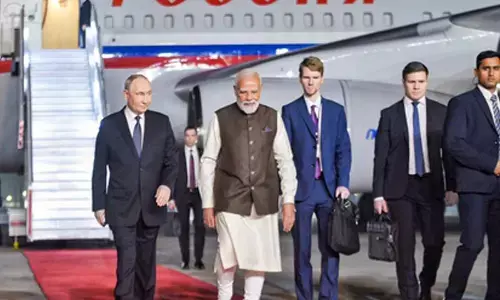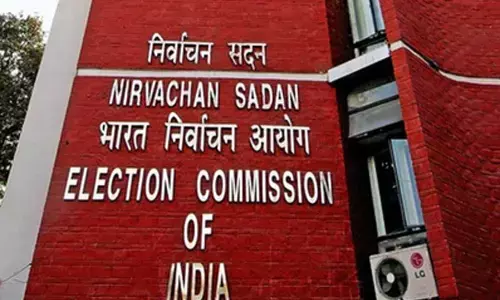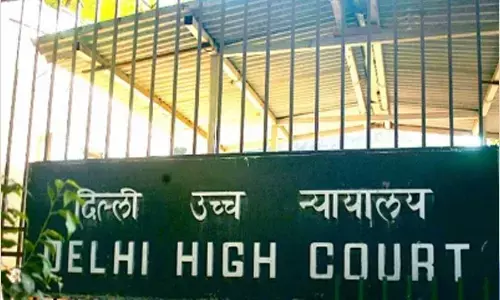Case for High Court in Rayalaseema

Finally, the High Court of Andhra Pradesh is moving to Amaravati. Buildings which were not available for the last four years have suddenly sprung up, though the construction of either temporary or permanent High Court buildings is yet to be taken up by the government. It may be in the interest of the present government to ensure that the High Court moves to Vijayawada area before 2019.
Finally, the High Court of Andhra Pradesh is moving to Amaravati. Buildings which were not available for the last four years have suddenly sprung up, though the construction of either temporary or permanent High Court buildings is yet to be taken up by the government. It may be in the interest of the present government to ensure that the High Court moves to Vijayawada area before 2019.
In the process, an irreparable damage is being done to the interests of Rayalaseema which the Rayalaseema leadership seems to have decided to sacrifice, which the generations to come from Rayalaseema may not excuse. To understand the dynamics of this, one has to look into the history of the formation of the state of Andhra in 1953.
When the Telugu speaking people of Madras Presidency sought a separate State and wanted to fight for it, the under-currents of mutual suspicion and lack of trust between Rayalaseema and coastal Andhra leadership became apparent. Even as early as 1937 Sri Bagh Pact was entered into where an agreement was reached between the elders of both the areas that as and when Andhra Pradesh State is formed the capital city will be located in Rayalaseema and the High Court in the Coastal area.
The spirit of the Sri Bagh agreement was that different institutions of the government will be distributed to attain regional balance which point the Sivarama Krishnan Committee subsequently reiterated 80 years later. It should not be forgotten that when the Andhra University was located in Visakhapatnam, people from Rayalaseema selected to be part of Madras university rather than become part of the Andhra University.
It is in this background when Pandit Nehru in principle agreed for creation of a separate State for Andhras insisted that the leadership arrives at an Agreement about the location of the Capital City. A meeting of leaders of Andhra Area took place under the leadership of Tangutoori Prakasam Pantulu at Madras.
Thenneti Viswanadham who wrote part of the autobiography of Tangutoori Prakasam Pantulu, titled “Naa Jeevana Yathra,” vividly describes the manner in which the discussions about the location of capital city were held. On that day, Gouthu Lachhanna from Srikakulam batted for location of capital at Tirupati, stating that as per the Sri Bagh Agreement the capital was to be located within Rayalaseema area and if it is not located at Tirupati, Chittoor may choose to stay with Madras Presidency.
All the Rayalaseema People Representatives prepared a petition and kept it with them to be used, if required, that in case the capital city was not located in Rayalaseema area, they would like to be with the Madras state. It was the Communists who batted for Vijayawada-Guntur area for location of the capital city of the State.
Since after discussions all through the morning no consensus could be arrived at, the decision was left to Tangutoori Prakasam Pantulu who asked everybody to assemble at 3 pm, and, when they assembled, he asked Gouthu Lachhanna to take a paper and pen, and write Kurnool as capital.
Nehru who was not in favour of linguistic states wanted the capital issue to be settled first before announcing the decision of a separate state, knowing fully well that it was not an easy issue to be decided given the sub-regional under-currents of mutual distrust. It is the visionary thinking of Prakasam Pantulu that saved the day.
He was aware if capital was not located in Rayalaseema they may choose to stay with Madras state strengthening the Nehru view on linguistic states. That’s how in 1953 the capital city was located at Kurnool and the High Court got located at Guntur as agreed to in Sreebagh Pact. Consequent on formation of the Andhra Pradesh State in 1956, both moved to Hyderabad.
It is the vision of the statesman of the stature of Tangutoori Prakasam Pantulu who could see the need for taking everybody along with in terms of the capital location, balancing the unique historical identities of regions of the coastal Area and Rayalaseema.
Compared to this, what happened in the location of Amaravati is a strategic manipulative exercise, wherein a decision to locate capital at this particular place was taken very early and was kept secret and suddenly in the Assembly the issue is brought up and the Opposition was made to fall in line.
This particular incident which happened on 4th September 2014, wherein the Rayalaseema leadership fell in the trap and meekly submitting without even lodging a protest on the issue, for which the generations to come from this area will not forget or forgive the leadership of the region. It is no secret that real estate, commercial and community interests played a vital role in capital city location.
Given this historical background and the need for balancing between the regions, it is but fair for the people of Rayalaseema at least to request for location of the High Court in their region, especially in the context High Court and the capital cities being located in different cities in nine States of the country. In States like Gujarat, Orissa, where there was an intense discussion about the location of capital city as a compromise formula, the High Court and the capital city are located in different places.
The regional issues of Andhra Pradesh State are going to come to the forefront one day or the other due to myopic policies of the present-day government and lack of vision in taking decisions which can impact generations in terms of regional relationships in the new state of Andhra Pradesh. (Writer is former Chief Secretary, Government of Andhra Pradesh)
By Krishna Rao Iyr















